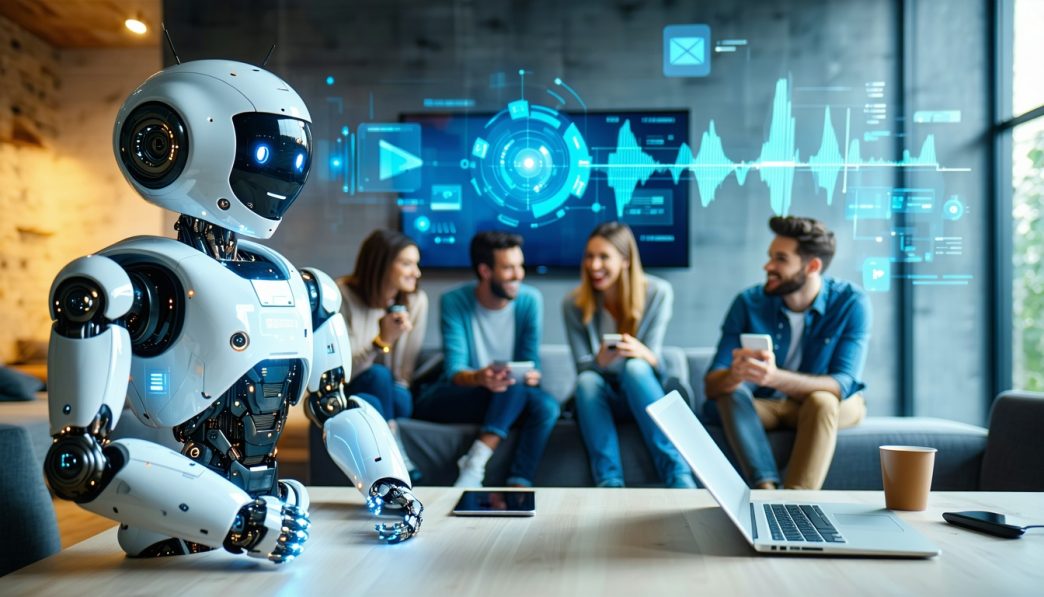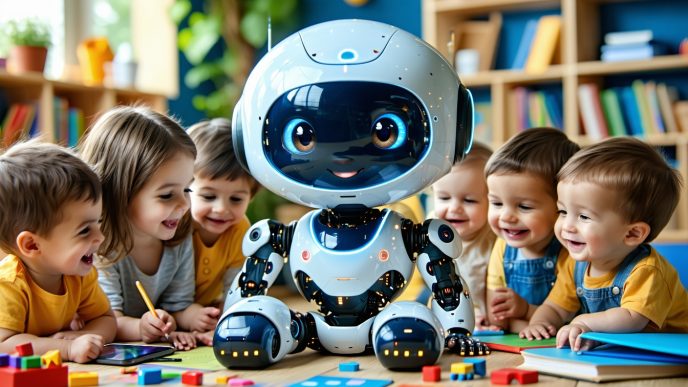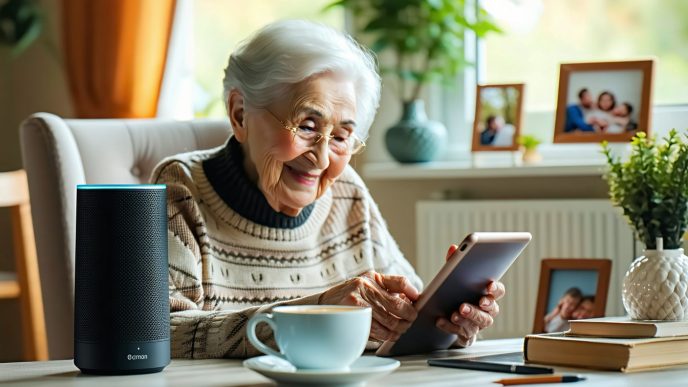The Rise of Voice Technology in Robotics
The integration of voice technology in home robotics marks a significant advancement in the way AI assistants interact with users. This evolution has transformed everyday tasks, making life more convenient and efficient for many.
Evolution of AI Assistants in Home Robotics
AI assistants have progressed significantly since their introduction, evolving from simple voice-activated tools to sophisticated systems that understand natural language and context. Initially, these early systems relied on basic command recognition, limiting their functional capabilities. As technology advanced, they began to incorporate machine learning algorithms and natural language processing, allowing them to learn from users and adapt over time.
Today, AI assistants are integral to various voice powered robots, facilitating interactions between users and their home environments. This evolution is evident in platforms like Alexa vs Google Assistant, where competition has driven rapid improvements in functionalities and user experiences. The following table shows the progression of AI assistants over time.
| Year | Features Introduced | Notable Advancements |
|---|---|---|
| 2011 | Voice recognition | Basic command execution |
| 2014 | Natural language processing | Contextual understanding |
| 2016 | Integration with smart home systems | Control over multiple devices |
| 2020 | Personalized interactions | Learning user preferences and routines |
Integration of Voice Technology in Modern Home Robots
Modern home robots have successfully integrated voice technology to enhance user interactions. These robots not only perform tasks but also respond to voice commands, making them more intuitive to operate.
For instance, robotic vacuum cleaners can be instructed to clean specific rooms or avoid certain areas through simple voice commands. Likewise, personal assistants can manage schedules, control lighting, and even provide reminders with ease. The seamless integration of voice technology allows for a cohesive smart home experience, connecting various devices and functions.
The adoption of voice technology has opened up new possibilities for home robotics, especially among tech-savvy families and professionals. Users can now enjoy a more interconnected environment, where they can control appliances and manage their homes effortlessly. For those interested in exploring how AI assistants work within different devices, refer to our article on ai assistants in appliances.
By embracing the capabilities of voice powered robots, users can streamline daily tasks and improve their overall quality of life. The development of these technologies continues to evolve, setting the foundation for even more advanced robotics in the future.
Benefits of Voice Powered Robots
Voice powered robots are revolutionizing the way individuals interact with technology in their homes. These intelligent devices offer several advantages that enhance convenience and streamline daily tasks. Here are some key benefits:
Enhanced User Experience
Voice controlled robots create a more intuitive and engaging user experience. Users are able to communicate with these devices through natural conversation, making interactions feel seamless. The integration of voice technology allows for quick access to information and services without the need for physical controls or screens.
For example, a study indicated that users preferred voice commands over traditional methods of input due to the speed and efficiency they provide. The following table illustrates user preferences in interaction methods:
| Interaction Method | User Preference (%) |
|---|---|
| Voice Commands | 65 |
| Touch Controls | 25 |
| Remote Controls | 10 |
This shift towards voice interaction reflects a growing trend where users find voice technology empowering and accessible.
Hands-Free Operation
One of the significant advantages of voice powered robots is the ability for hands-free operation. Users can engage with these devices while tending to other tasks, such as cooking or cleaning, leading to greater multitasking efficiency.
This hands-free capability is particularly beneficial for smart home adopters who have multiple devices connected in their environment. A simple voice command can control various appliances, adjust lighting, or set the temperature, allowing individuals to maintain focus on other responsibilities.
Personalized Interactions
Voice powered robots also provide personalized interactions tailored to individual preferences. Advanced voice recognition technology enables these devices to understand different voices and can differentiate between users. This allows for customized responses and recommendations based on user history and preferences.
For instance, robots can create personalized routines based on family members’ schedules, or provide specific alerts relevant to their interests. The following table outlines potential personalized features users might experience:
| Personalized Feature | Description |
|---|---|
| Custom Routines | Create routine tasks for different times of day |
| User Recognition | Deliver individualized information based on voice |
| Preference Learning | Adapt responses based on previous interactions |
Personalized interactions encourage users to connect more deeply with their voice powered robots, improving overall satisfaction and engagement.
Voice powered robots are not only about functionality but also about enhancing the quality of life at home. As technology continues to evolve, the benefits of these intelligent devices will only expand, offering even greater convenience and support for users. For more information on the relationship between artificial intelligence and home environments, explore our article on ai assistants and smart homes.
Types of Voice Controlled Robots
Voice powered robots come in various forms, each designed to enhance the efficiency and convenience of daily tasks. The main types of these robots include robotic vacuum cleaners, personal assistants, and security robots.
Robotic Vacuum Cleaners
Robotic vacuum cleaners are among the most popular types of voice controlled robots found in homes today. These devices utilize voice commands to perform cleaning tasks autonomously. Users can instruct the robot to start or stop cleaning, schedule cleaning times, or direct it to specific areas of the home.
| Feature | Description |
|---|---|
| Voice Command Activation | Allows users to initiate cleaning via voice commands. |
| Smart Navigation | Utilizes sensors to navigate furniture and avoid obstacles. |
| Cleaning Modes | Users can select different modes such as quick clean, spot clean, or deep clean. |
These devices integrate seamlessly with AI assistants, allowing users to combine their voice technology capabilities with their home cleaning routines. For more insights, explore our article on ai assistants in appliances.
Personal Assistants
Personal assistants equipped with voice technology have transformed the way individuals interact with their home environments. These AI-driven robots can manage tasks such as setting reminders, controlling smart home devices, and providing information based on voice inquiries.
| Feature | Description |
|---|---|
| Voice Interaction | Responds to user queries and commands effectively. |
| Smart Home Integration | Controls various smart devices like lights, thermostats, and locks. |
| Routine Management | Can schedule events, send reminders, and track tasks. |
These assistants enable users to seamlessly integrate technology into their daily lives. For comparisons between different AI assistants, check out our article on alexa vs google assistant.
Security Robots
Security robots are designed to enhance home safety through voice commands and automated monitoring. These robots are equipped with cameras and sensors to patrol premises and provide real-time alerts to users.
| Feature | Description |
|---|---|
| Remote Monitoring | Users can check live feeds directly from their devices through voice commands. |
| Automated Patrol | Can navigate predefined paths within the home or property. |
| Alert Notifications | Sends alerts about unusual activity or security breaches. |
Voice technology enhances the functionality of security robots, making it easy for users to interact with their security systems. To learn more about privacy considerations, refer to our article on privacy and ai assistants.
Voice controlled robots are becoming integral to smart home ecosystems, improving convenience, efficiency, and safety. Each type of voice powered robot serves a unique purpose, catering to the diverse needs of tech-savvy families and professionals.
Voice Technology Features
As the adoption of voice powered robots increases, understanding the core features that enable their functionality becomes essential. These features include speech recognition, natural language processing, and voice command capabilities, each contributing to a more intuitive interaction with technology.
Speech Recognition
Speech recognition is the technology that allows voice powered robots to understand spoken language. This feature enables the robot to convert audio into text, making it possible to interpret commands. High-quality speech recognition systems can differentiate between various accents, dialects, and speech patterns, allowing for more inclusive usage.
| Feature | Description |
|---|---|
| Accuracy Rate | 90% – 95% depending on the environment |
| Response Time | Typically ranges from 200 ms to 1 second |
| Languages Supported | More than 20 languages for global accessibility |
Devices equipped with advanced speech recognition can effectively understand user commands from a distance, providing reliability in various household scenarios. This capability is crucial for enhancing user experience in homes equipped with multiple AI assistants like alexa vs google assistant.
Natural Language Processing
Natural language processing (NLP) allows voice powered robots to comprehend and process human language in a meaningful way. NLP enables robots to interpret the context and intent behind spoken commands, making interactions smoother and more efficient.
Key components of NLP include:
- Text Analysis: Understanding the structure and meaning of sentences.
- Sentiment Analysis: Recognizing the emotional tone behind words.
- Contextual Understanding: Grasping the context in which commands are issued.
With NLP, robots can provide more personalized interactions, which is essential for fostering a seamless integration within smart home environments. This technology is a key factor in the evolution of ai assistants and smart homes.
Voice Command Capabilities
Voice command capabilities empower users to issue direct commands to robots, controlling various functions with their voice. This feature is pivotal for the hands-free operation of devices in a household, allowing users to multitask and streamline their daily routines.
| Command Type | Examples |
|---|---|
| Basic Commands | “Turn on the lights”, “Set a timer for 10 minutes” |
| Advanced Commands | “Play my morning playlist”, “Adjust the thermostat to 72 degrees” |
| Contextual Commands | “Prepare my coffee as I did yesterday” |
Voice command functionality enhances convenience and accessibility, especially for users managing multiple tasks at once. This interaction model opens the door to numerous ai assistant use cases in various settings, from daily household chores to enhancing elderly support with ai assistants for elderly support.
Understanding these voice technology features helps users appreciate the capabilities of voice powered robots, ensuring they can leverage these tools for maximum benefit in their smart homes.
Future Trends in Voice Powered Robots
The future of voice powered robots is bright, with advancements in technology paving the way for more integrated and responsive systems in our homes. Innovative developments are enhancing the capabilities of these devices, making them more valuable tools for everyday life.
Integration with Smart Home Devices
As voice technology continues to evolve, its integration with smart home devices is becoming increasingly important. This seamless connection allows for better automation and control over various systems within the home. Voice powered robots can coordinate with smart lights, thermostats, locks, and appliances, creating a cohesive ecosystem that enhances user experience.
One study found that users of integrated smart home systems experienced a significant improvement in convenience and energy efficiency.
| Integration Aspect | Benefits |
|---|---|
| Smart Lighting | Control brightness and color through voice commands |
| Smart Thermostats | Adjust temperature settings based on voice prompts |
| Security Systems | Activate or disable security features hands-free |
For those interested in how AI assistants complement smart homes, a detailed exploration can be found in our article on ai assistants and smart homes.
Advancements in Artificial Intelligence
Artificial intelligence plays a crucial role in the development of voice powered robots. As AI continues to advance, these robots will become more adept at understanding user commands, nuances in speech, and contextual information. Enhanced algorithms and machine learning capabilities will allow for improved interactions and more personalized experiences.
Recent advancements in AI have resulted in a notable increase in the accuracy of voice recognition technologies. Studies indicate that the accuracy of voice recognition can exceed 95% with state-of-the-art AI systems.
| AI Development | Impact |
|---|---|
| Improved Speech Recognition | Higher accuracy in understanding commands |
| Contextual Awareness | Ability to respond based on previous interactions |
| Machine Learning | Continuous improvement in responsiveness |
For practical applications, explore our insights on ai assistant use cases.
Customization and Adaptability
Customization will play a significant role in the future of voice powered robots. Users will have the ability to tailor functions and responses to their specific needs and preferences, making the devices more intuitive and user-friendly. This adaptability extends to personal settings, routines, and even language preferences.
For example, families can customize their voice assistants to respond differently based on who is speaking, ensuring a more personalized interaction. The ability to adapt to individual user profiles can enhance usability, especially for homes with diverse age groups and tech-savviness.
| Customization Feature | Benefits |
|---|---|
| User Profiles | Personalizes responses and settings for each family member |
| Routine Programming | Automates daily tasks based on schedules |
| Language Selection | Offers multi-language support for diverse households |
Families looking for AI assistants catered to specific needs, such as for elderly support or kids, can find insights in our articles on ai assistants for elderly support and ai assistants and kids.
These advancements indicate a promising future for voice powered robots, providing greater convenience and enhancing the quality of life for users.
Considerations for Voice Controlled Robots
As voice technology becomes increasingly integrated into robotics, there are several considerations that users should keep in mind when adopting voice powered robots. These elements can impact their effectiveness and the overall user experience.
Privacy and Security Concerns
One of the primary concerns with voice controlled robots is privacy. Voice-activated devices continuously listen for commands, leading to apprehensions about data security and unauthorized access to sensitive information. Users must ensure that their chosen devices have robust security measures in place to protect personal data.
Data storage practices also play a vital role in user privacy. Individuals should inquire about how their voice data is recorded, stored, and whether it’s shared with third parties. Awareness and understanding of these issues can help mitigate worries. For further insights, refer to our article on privacy and ai assistants.
| Concern Area | Description | Suggested Action |
|---|---|---|
| Data Security | Risk of unauthorized access | Use devices with strong encryption |
| Voice Data Storage | How and where data is stored | Regularly review privacy settings |
| Third-Party Sharing | Potential sharing of data | Choose devices with clear policies |
Compatibility with Existing Systems
Another essential consideration is compatibility. Voice powered robots must work seamlessly with existing devices and home automation systems. Before integrating a new robot, users should check whether it can effectively communicate with their current devices, such as smart lights, thermostats, and other AI assistants.
Users may find it beneficial to choose robots that are compatible with multiple ecosystems, allowing for broader integration options. Reviewing resources on ai assistants and smart homes can provide guidance on selecting compatible devices.
| Device Type | Compatibility |
|---|---|
| Smart Lights | Must support same protocols |
| Thermostats | Should work within existing network |
| Other AI Assistants | Look for interoperability features |
Upgradability and Long-Term Support
When selecting voice controlled robots, users should also consider the upgradability of the devices. Technology evolves rapidly, and having the option to update software or firmware can enhance functionality and improve performance over time.
Long-term support from manufacturers is also vital. Users should investigate the track record of the manufacturer regarding software updates, bug fixes, and customer support. Ensuring that a robot will receive continued support can increase its longevity and usefulness. For ideas on everyday uses, explore our content on ai assistant use cases.
| Upgradability Factor | Description |
|---|---|
| Software Updates | Regular enhancements to features |
| Customer Support | Access to help for troubleshooting |
| Device Longevity | Expected lifespan of the robot |
Considering these factors—privacy, compatibility, and upgradability—can lead to a more satisfying experience with voice powered robots, helping users maximize the technology’s benefits in their daily lives.















